Borghamn is the largest village in Vadstena's southern community. The latter is often referred to as Dal or Östgöta Dal. Dals härad (Hundred), was a legal entity, which in the Middle Ages was formed by the small rural communities of Väversunda, Rogslösa, Källstad, Herrestad, Örberga, Nässja and, for a time, St. Peter's (St. Per) and Strå. For many years Västerlösa Gård at the entrance to Borghamnwas the only settlement in the area and the residence of the Hundred's governor.
Östgöta Dal's rural community was established in this area during the 1952 reform and only fifteen years later, Östgöta Dal was merged into the town of Vadstena. But the terms Dal and Östgöta Dal have survived to this day.
Dal is not only Sweden's granary with the best soils in Sweden, but also part of the cradle of Sweden. After the Viking era, the Swedish state developed here in Götaland. Dal is home to Sweden's oldest stone churches from the beginning of the 12th century: Herrestad and Örberga.
But unlike other places in the area, Borghamn is not agricultural shaped or developed around a manor and a manor church, but originated from industrial activities, the oldest of which has been practiced here for 900 years: the quarrying of limestone.
Some things have passed, like fishing. Older visitors remember the whitefish festivals that were once celebrated on the Hovanäsudde. But new businesses have also sprung up, and Borghamn has renewed itself in this way and has evolved over time.
There is no church in Borghamn, but there is an old cemetery belonging to the town. No tombstones are visible in it - the graves are anonymous - but two memorial stones were erected nearby - for two dogs: Oden and Zenta
If you look at the directory or on the map, there is a lot to discover in Borghamn and the surrounding area: the Omberg Mountain have not yet been named as an Ecopark with its diverse flora and the lake Tåkern with its rich bird life. Omberg and Tåkern are dedicated to separate pages.
Several roads lead to Borghamn. The Borghamnsvägen from the former highway 50 (today state road 919) to the harbour is the most important and heavily frequented.
From Skedet to Västerlösa is the Skedagatan, which was populated during the period of strong population growth in the 19th century. However, most summer visitors come to Borghamn via the Omberg and Sjövägen (Lake Road), a one-way road that starts in Stocklycke and runs along Lake Vättern to Borghamn with magnificent views.
And the first thing the traveller sees when he descends from Drottnings Ommas Castle into the plains is a harbour and quarry. This is where the history of Borghamn began over 900 years ago.
Borghamn is the northern gate to Omberg and Borghamn Strand is the ideal starting point. Borghamn Strand opened in 2019 in the historic harbour premises. Here you can stay all year round and start your hikes, cycling excursions, kayak and boat trips or fish in Lake Vättern.
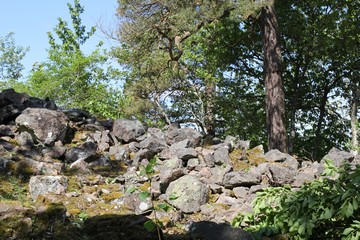 Drottning Ommas Borg
Drottning Ommas Borg
1. Drottning Ommas Borg
Northernmost of three hill forts from the migration period (450-550) on the Omberg. There are many legends
surrounding Queen Omma. The Swedish poet Verner von Heidenstam (1859-1940) wrote the poems "Bygdeborgen"
and "Skogen susar" about Queen Omma.
Drottning Omma is said to have lived in the northernmost castle, just above Borghamn. A girl from the village was abducted into the castle to be raised to the new queen after the old one. Drottning Omma always wore a mask. Granmar, who had lost his fiancée to Omma, visited her and killed her just to find out that it was his fiancée he had killed. The exchange had already been completed.
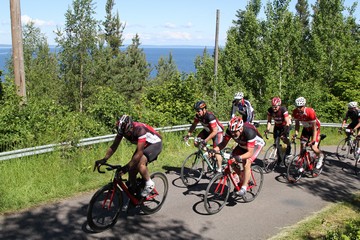 Sjövägen (Lake Road) during the Halvvättern cycling competition
Sjövägen (Lake Road) during the Halvvättern cycling competition
2. Sjövägen (Lake Road)
The Lake Road starts in Stocklycke on the Omberg and runs as a one-way street along the steep coast to Lake
Vättern as far as Borghamn. Landscape and views are magnificent.
3. Vallgatan
The Vallgatan runs east of Sjövägen from Drottning Ommas Borg to Höje. It is closed to general traffic.
4. Brottsledet
In the first half of the 17th century, the Omberg became a royal state enclosure and deer park and was surrounded
by a fence about four metres high, which the local farmers had to maintain. Names like östra and västra djurledet
as well as Brottsledet are remnants of the time: gates in the fence.
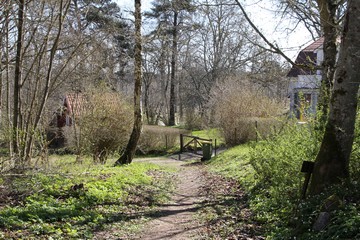 Svängavägen at Brottsledet
Svängavägen at Brottsledet
5. Svängavägen
The Svängavägen was the old ascent from Borghamn to Omberg and Vallgatan. In 1972 the Sjövägen was directly
connected to Borghamnsvägen through the quarry. Due to the southern extension of limestone quarrying, the
Svängavägen was interrupted in two places. The expansion of the limestone mining also affected a part of
the settlements at Svängavägen.
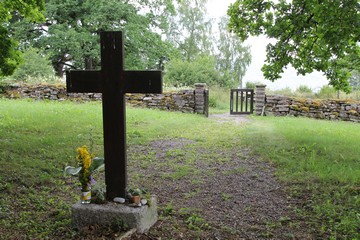 Bockakyrkogården
Bockakyrkogården
6. Bockakyrkogården
The small cemetery is idyllically situated in the middle of a grove of mighty oaks and hazel bushes under the
northern slopes of Omberg. The small hills conceal about 80 graves of men from the Crown Labour Corps, i.e.
prisoners who worked in Borghamns limestone quarry . They quarried stone for the fortress of Karlsborg on the
western shore of the Vättern. A simple wooden cross has been erected at the site: "Here, between 1860 and 1894,
around 80 men from the Crown Labour Corps were buried. They quarried stone for the Karlsborg fortress."
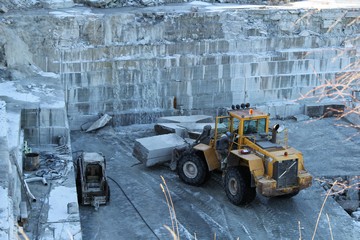 Borghamn's limestone quarry
Borghamn's limestone quarry
7. Borghamn's limestone quarry
Limestone has been used in Sweden as building material since the beginning of the 12th century. Here in Borghamn, the Cistercian
monks began to break limestone for their monastery in Alvastra, which was consecrated in 1143. Since then,
the quarry has been used continuously to this day. Other important buildings using limestone from Borghamn
were the monastery church in Vadstena, the Götakanal, Karlsborg Fortress and the National Museum.
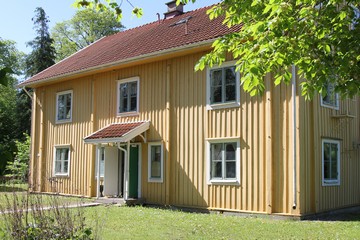 Fortification house "Kommendanten". Oldest dwelling in "old Borghamn".
Fortification house "Kommendanten". Oldest dwelling in "old Borghamn".
8. Borghamn Strand
Borghamn Strand was opened in April 2019 in the old premises of the former Borghamn School and is a popular
destination for hikers and day visitors in Borghamn and on Omberg. Here you will find accomodation with hotel and
hostel standard, a harbour café, sauna and kayak rental.
The facility was a work station under the direction of the Crown Labour Corps, after the swedish state bought the quarry and harbour in 1842.
The entire area has been declared a listed building since 1993 (Borghamn School) and registered as a working life museum since 2023. Read more on Borghamn's listed buildings.
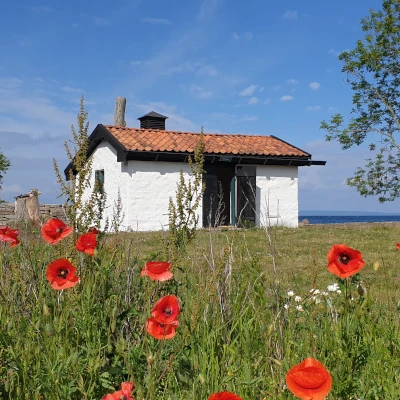 Laundry house (Former Fishing Museum)
Laundry house (Former Fishing Museum)
9. Laundry house (Former Fishing Museum)
The Fishing Museum was housed in the former laundry building of the Kronoarbetskorps and displayed equipment and
fishing methods from Borghamns history. It's now closed.
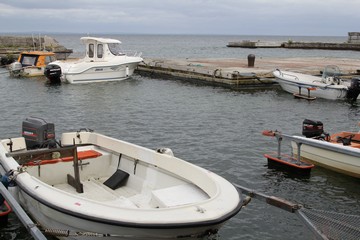 Borghamn's harbour
Borghamn's harbour
10. Borghamn's harbour
The western part of the harbour in Borghamn was built between 1810 and 1827 by the Göta Canal Company to cope with
deliveries to the construction sites on the Göta Canal between Motala and the Baltic Sea. In the second half of the
19th century, the eastern part was added with the so-called Bondbryggan for the transport of grain to Western Götaland.
11. Borghamnsten AB
Borghamnsten AB is the successor of all companies and the Swedish state that have quarried limestone here at Omberg.
Limestone and marble are processed. The company produces worktops, window sills, floors and claddings. One reference
is the NK (Nordiska Kompaniet) department store in Stockholm.
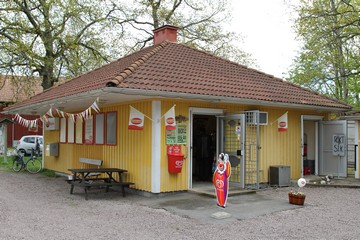 Borghamn's Kiosk and Fish
Borghamn's Kiosk and Fish
12. Borghamns Kiosk och Fisk
Today's land trade was inaugurated in 1998, but has a tradition that goes back to 1938, when a kiosk opened here.
It was a central meeting point for the local population and the first stop for many visitors who came to Borghamn
from Omberg. Speciality of the house are fresh and smoked vätternfish caught by Borghamns last fisherman.
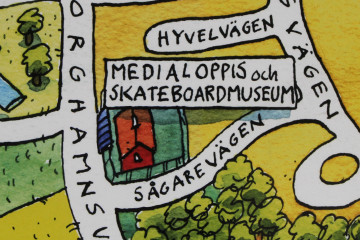 Blå Grinden
Blå Grinden
13. Blå Grinden / Medialoppis / Skateboard museum
Blå Grinden is a craftsman's shop. Media Loppis was a trade in second-hand computers, music systems, DVDs, etc.,
but has since closed down.
Hidden in the building is Lars Söderbergs Skateboard Museum, which shows skateboards, wheels, shoes,
helmets, knee pads, games and posters in a blissful mixture.
14. Västerlösa Gård
Västerlösa gård was the only settlement in the area for many hundreds of years and Dals Hundred's "hövding's"
(governor's, judge's) pay residence. .
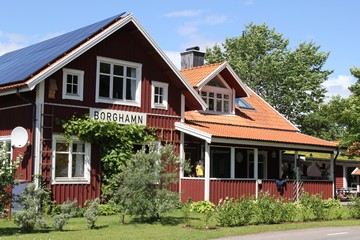 The old station building
The old station building
15. The old station building
The railway between Vadstena and Ödeshög was opened in 1888. The train station was centrally located between the
districts of Västerlösa and Bårstad. The connection was closed in 1958.
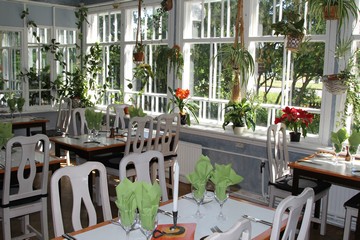 Gyllenhammars Restaurant
Gyllenhammars Restaurant
16. Gyllenhammars Pensionat
The railway connection between Linköping and Vadstena led to the development of tourism in the Omberg area.
Gyllenhammar's pension opened in 1914 next to the station building. Today, Gyllenhammars is a highly esteemed
restaurant, which offers jazz evenings and other experiences. Open from Easter to October.
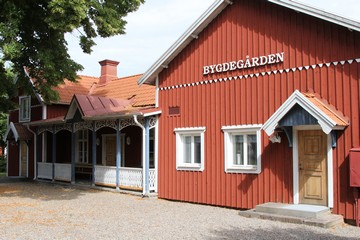 Bygdegården
Bygdegården
17. Bygdegården / Logen
The Omberg Lodge was formed in 1896 and at the end of the 1890s they built their own assembly hall, which was
expanded in 1906 with a larger theatre and a small general store. After extensive renovation, a newly formed
community centre association took over its operation. With the closure of the community centre association at the
end of 2024, this era also ends. The building is now run by Vadstena municipality, which has gathered various
activities under the roof, including the Borghamn branch of the municipal library.
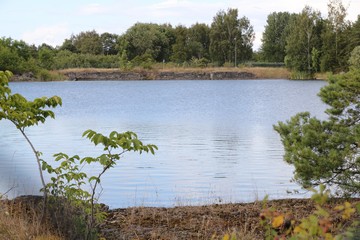 Bårstad's former limestone quarry
Bårstad's former limestone quarry
18. former Bårstad's limestone quarry
In the now water-filled quarry (1860-1960) limestone was broken for the lime kiln on Hovanäset and Bårstad's lime
kiln (from 1908 onwards).
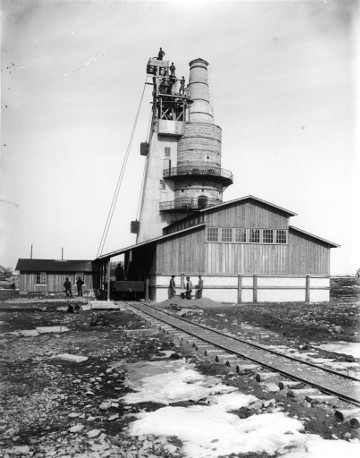 Bårstad's former limekiln. Photo: Arkiv Förening Gamla Vadstena
Bårstad's former limekiln. Photo: Arkiv Förening Gamla Vadstena
19. former Bårstad's limekiln
Lime was burned for agriculture and bricklaying on the open area opposite the water-filled quarry.
The furnace was dismantled in 1972.
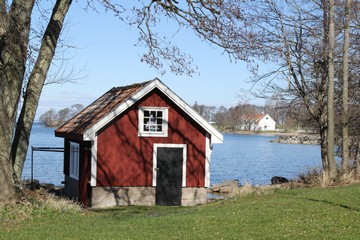 In the fishermen's village
In the fishermen's village
20. Fishermen's village
From the beginning of the 19th century to around 1960, fishing was an important industry in the village.
The oldest fishing population lived on Hovanäset. The first port was built about 200 years ago. At the end
of the Second World War there were 18 professional fishermen with their families who fished char, burbot,
whitefish and vendace.
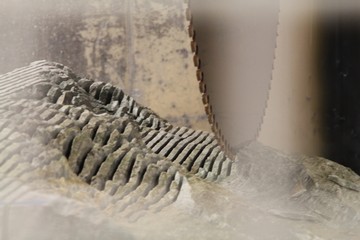 Modern saw in the Borghamns Stenförädling
Modern saw in the Borghamns Stenförädling
21. Borghamns Stenförädling AB
Borghamns Stenförädling AB was founded in 1951 and mainly produces and refines material from its own quarries.
Borghamn produces light grey and greyish-brown Borghamn limestone, while Kolmårdsmarble is extracted from Oxåker.
This results in floors, stairs, window sills, worktops, wall coverings, garden stones and much more. The company
is also involved in the recent renovation of the National Museum in Stockholm.
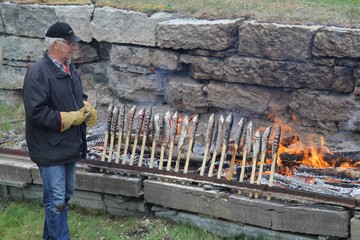 Roasting of whitefish (Sik)
Roasting of whitefish (Sik)
22. Hovanäset
Hovanäset was a part of the village of Bårstad with Torp. From 1860, one of the landowners of Bårstad started a
distillery, mill and lime kiln as well as a dairy at the barn on Trädgårdsudde and his own boat harbour. Remains
of these activities can still be seen today on the tongue of land. They were discontinued at the beginning of the
20th century. A new lime kiln was built opposite Bårstads limestone quarry.
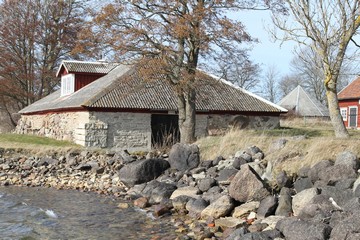 Östgöta Dals hembygdsgård / Museum building
Östgöta Dals hembygdsgård / Museum building
23. Hembygdsgården / Local History Museum
The local homeland association uses the old buildings on Hovanäset. The local history museum shows the stone
industry in Borghamn, a complete shoemaker's workshop, utensils, a flat from the twenties and fifties, handicrafts
from wire by the migrant worker "Öland".
There is no scheduled service to Borghamn. But at Östgötatrafiken you can book journeys between Vadstena and northern Omberg. Read more on Östgötatrafiken - Närtrafik (In swedish only, use translation function for information in English).
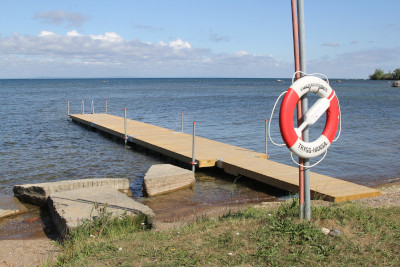 Bårstad's bath
Bårstad's bath
24. Bårstads udde (Bathing area and dog bath)
Bårstads udde offers a bathing place (in the eastern direction) and a dog bathing place (in the western direction
from the access road).
25. former Bårstad's village
Bårstad was first mentioned in documents at the beginning of the 13th century. The old village consisted of six
farms before the land reform of 1827 (laga skiftet) was carried out. Two farms remained, while the four others
settled outside, nearer to the bathing area or in the direction of Borghamnsvägen.
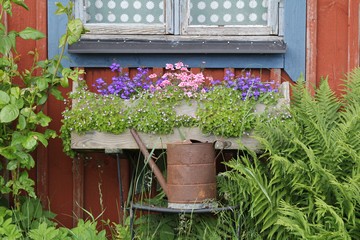 Skedagatan, Stensäter
Skedagatan, Stensäter
26. Skedagatan
Skedagatan is located on the border between Rogslösa and Väversunda. At the outskirts or border between two
municipalities, people settled from the middle of the 19th century at the time of the great population growth,
as long as they did not emigrate or move to the larger cities.
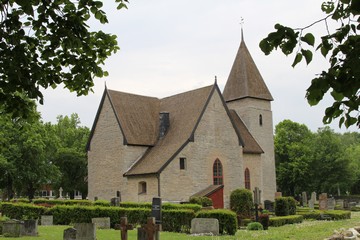 Rogslösa church
Rogslösa church
27. Rogslösa church
Rogslösa church has a very long building history from the middle of the 11th century to the end of the 13th century
and was originally built as a court church. The church at that time replaced an earlier wooden building.
Architecturally, the building contains elements of Cistercian building culture under the influence of the Alvastra
monastery. The church is best known for its entrance portal with the so-called Rogslösa door, which is decorated
with forged iron depictions of the Fall and St Eustachius.
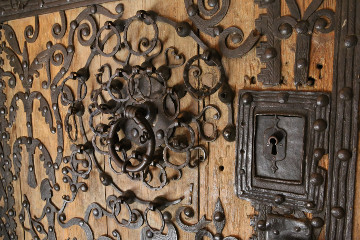
Amongst others, Lydia Wahlström (1869-1954), an active member of the Swedish voting rights and women's movement, the majority of the "incomparable" sisters from Häckenäs and Jonas Andersson, a member of the parliament from Häckenäs, co-founder of Östgöta Dals and Östergötland's Volkshochschule, are buried in the cemetery.
With the construction of the railway Vadstena-Ödeshög a settlement developed around the railway station. Rogslösa was the seat of the former Östgöta Dals rural community.
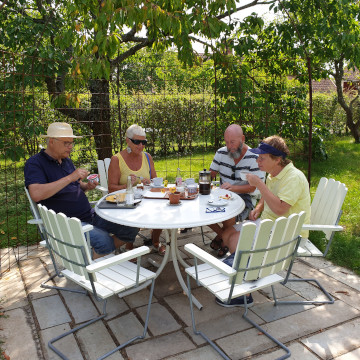 Kafé på Skedet
Kafé på Skedet
28. Kafé på Skedet
Kafé på Skedet is a popular summer café, famous for its pastries and bread, pub afternoons, so called "middagsklubben",
music entertainment and art exhibitions. Café open thursday-sunday 11-17, pub friday 17-22.
¨46-73-702 2097.
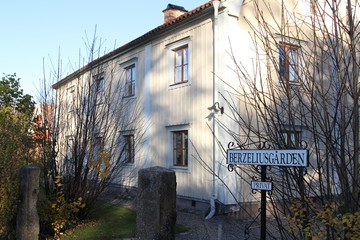 Berzeliusgården
Berzeliusgården
29. Berzeliusgården
Birthplace of Jöns Jacob Berzelius
(1779-1848), chemist and naturalist. He discovered the elements cerium, selenium,
silicon and thorium. There is also a small exhibition about him in the nearby parish hall, which is open daily
during the summer from 9am to 6pm and on other occasions.
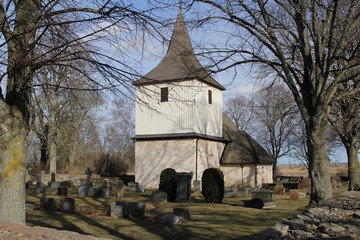 Väversunda church
Väversunda church
30. Väversunda church
A romanesque and best-preserved medieval church from about 1160, built of Ombergs limestone. The predecessor
was probably a stave church.
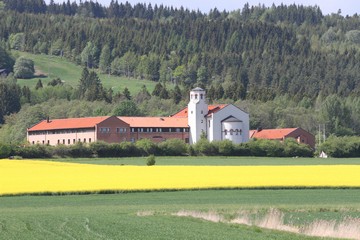 Hl. Hjärtas kloster (Convent of the Sacred Heart)
Hl. Hjärtas kloster (Convent of the Sacred Heart)
31. Hl. Hjärtas kloster (Convent of the Sacred Heart)
The Convent of the Sacred Heart is located on a beautiful natural slope on the Omberg hill, which was inaugurated
in 1997. Here the sisters live a monastic life according to the rules of St. Benedict with the Virgin Mary as mother
and example.
Gyllenhammars Restaurant
Open from Easter to autumn. In summer daily excepts for Tuesdays, in spring and autumn on weekends (Friday-Saturday).
+46-143-200 02.
Borghamns Kiosk and Fish
Open daily 11-18.
Kafé på Skedet
Kafé på Skedet is a popular summer café, famous for its pastries and bread, pub afternoons, so called "middagsklubben",
music entertainment and art exhibitions. Café open thursday-sunday 11-17, pub friday 17-22.
¨46-73-702 2097.
Borghamn Strand
Open for overnight stays from spring to autumn. Café and restaurant open 11-17 every day in summer, weekends in
autumn and spring. +46-143-10 999.
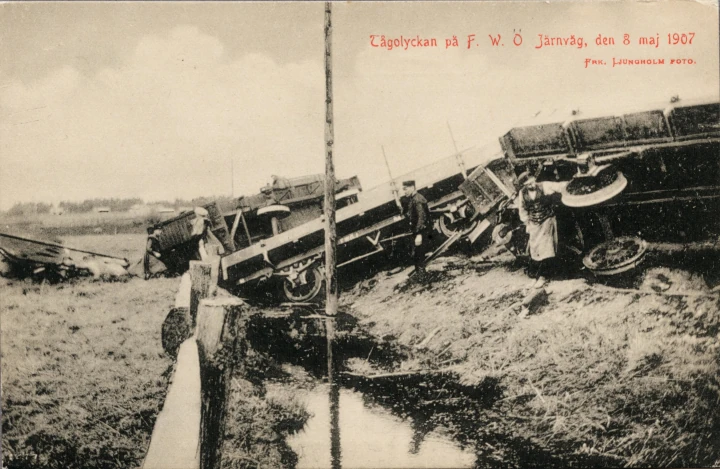
Greetings from Borghamn: Train accident on F.W.Ö. Railway on 8 May 1907
Derailment at Bårstad bog between Rogslösa and Borghamn on the Fågelsta - Vadstena - Ödeshög railway, FVÖJ on 8 May 1907. The train was on its way to Ödeshög, when a break occurred on a carriage axle. The wagons were loaded with sugar in sacks, which were going to Ödeshög. No one was injured.
In 1874, the narrow gauge railway from Vadstena to Fågelsta was put into operation. The company was financed by Vadstena town. This gave the town a connection to the Hallsberg-Motala-Mjölby railway and the modern transport infrastructure.
A new company was formed and the line was extended via Hästholmen to Ödeshög in 1888. In Hästholmen, a branch line led to the harbour.
This connection contributed greatly to the development of tourism on Omberg: a railway hotel was built at Alvastra station and the tourist hotel on the southern slope of Omberg (1892). Borghams Turisthotell (Ombergspensionatet) followed in 1900, Gyllenhammars Pensionat in Borghamn in 1914 and Stocklycke vandrarhem in 1934.
Freight traffic was limited. The accident on 8 May 1907 just before the entrance to Borghamn remained the only one during regular hours. The railway between Vadstena, Hästholmen and Ödeshög has been closed since 1958. The Vadstena-Fågelsta section remains as Sweden's oldest narrow gauge railway in operation (museum railway WFJ with summer traffic and bicycle draisine hire).
Photo: Swedish Railway Museum
More picture postcards from Borghamn can be found on Greetings from Borghamn.